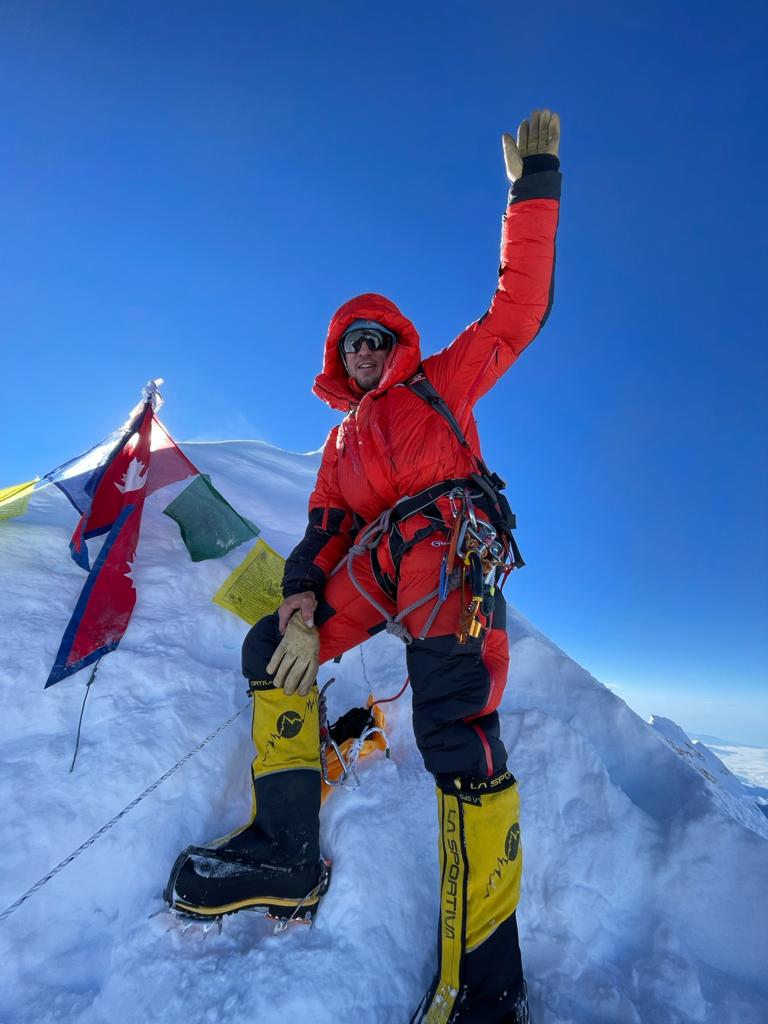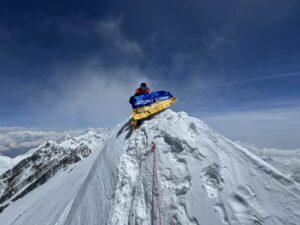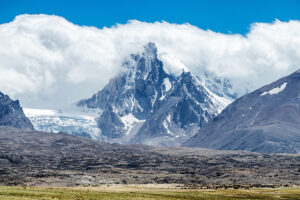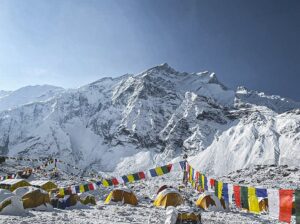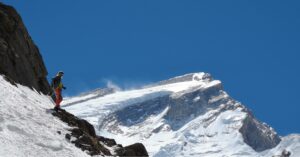There are more summit reports from Manaslu teams today, including Mingma G’s Imagine Nepal. He announced that 22 people reached the “real summit of Manaslu”. No photographs or details are available yet.

Imagine Nepal’s summit list as posted on Instagram today.
Meanwhile, British guide Jon Gupta has just returned to Base Camp after a successful day. However, he honestly admitted, “We went to the end of the ropes, but I don’t think (or I don’t know) if it is the true summit. It felt like a summit, even if it is technically a few metres short.”
The lead photo in this story shows his summit point. He also sent a shot of the summit ridge (below), noting: “I think the furthest point may be higher, but if so, only by a metre or two.”

Manaslu’s summit ridge today. Photo: Jon Gupta/Mountain Expeditions
Conditions today were “perfect up there”, said Gupta. “Some trail-breaking to be done, but we left quite late since we were on oxygen. Now there is a great trail for those heading up in the next day or two.”
Summit Weekend
A large number of teams on Manaslu have made for the summit all weekend and today, with apparently high success rates. However, the few summit pictures shared so far on social media lack a geographical reference and don’t show for perspective the usual foresummit where rope-fixing teams typically stop. ExplorersWeb is currently asking a number of Manaslu summiters for their feedback.

A supposed Manaslu summit picture, taken by India’s Ratan Singh Sonal and Anoop Kumar. Note the further snow domes behind. Photo: ITBP Official Twitter
Only Mingma G has mentioned the word “real” summit about his team’s achievement today. The main question is whether Mingma G considers that the real summit is simply a little further than the point reached by previous climbers.
If they did reach the summit, how did such a large team handle the 20 to 50m between the foresummit where ropes usually end and the highest point of the mountain: a sharp, exposed ridge?
If Mingma G was uniquely successful, we can also expect reactions from those who reached the “ropes’ end-point” on previous days…and previous seasons, because it will then become more glaring that they did not actually summit.
But why not go all the way?
As professional guide Guy Cotter told ExplorersWeb some weeks ago, in the last few years, expedition leaders may have considered that last section too risky or difficult to fix and decided that one of the ridge’s foresummits was close enough. “It doesn’t matter that much, as long as one is totally honest,” Cotter said. “If there is a good reason, especially safety, why you don’t get to the highest point, that’s no problem.”
In a previous chat with ExplorersWeb, Jon Gupta shared a similar opinion, saying that he would do his best to reach the highest point, but putting his client’s safety first. “I am carrying a rope and extra gear to use if required, but we’ll have to wait and see until we are up there,” he said.

Guy Cotter years ago on the true summit of Manaslu. Photo: Guy Cotter/8000ers.org
Indeed, “foresummitting” Manaslu may not be a big deal for someone who just wants to experience climbing the mountain. But the rules are different for those pursuing a record or a formal challenge such as the 14×8000’ers. This includes Pakistan’s Shehroze Kashif, who is aiming for an age record and who summited Manaslu (or so he claimed) on Saturday, his fourth 8,000’er.
Then there is the case of Nirmal Purja, who reached the end of the ropes on Manaslu in 2019, as part of his 14×8,000’ers speed record. Purja and his Elite Exped team have reported summiting today as well. It will be interesting to know whether today’s summit point is different from 2019’s foresummit.
There is another potential scenario. If Mingma G declared that the ropes ended at the real summit, it would appease all the other expedition leaders and their clients. However, he would have to back this up with unmistakable summit proof and detailed pictures and reports. Otherwise, it would only heat up the debate and damage the credibility of outfitters on these mountains, given the information available these days.
An 8,163m mess
The controversy around Manaslu’s true summit is not new. The climbing community has known about it and debated it for decades, if not openly at first. In recent years, however, it has become much more difficult to get permission to climb Tibet’s relatively easy 8,000’ers, Shishapangma and Cho Oyu. Manaslu has largely taken their place, and the number of guided clients has increased sharply.
So many clients so dependent on fixed ropes has prompted outfitters to “declare” a less technical place as the summit point. Yet a summit will always be, as the late Iñaki Ochoa pointed out, “the place where everything else is downhill”.
Then came the thorough research carried out by a number of experts and over 20 Manaslu summiters, coordinated by 8000ers.com.
The report detailed all the points on Manaslu’s summit ridge and clearly stated where the real summit was. Since it was published in 2017 (and updated in May of this year), it has sent shivers up the spine of many climbers.
“I have nightmares about the Manaslu summit since I read that report because I am not sure anymore that I reached the true summit,” a European climber told ExplorersWeb recently.
Another admitted: “I have to assume that, if I want to complete the 14×8000’ers, I will have to return to Manaslu.”
While Manaslu’s summit area may confuse some, the Japanese pioneers who first summited Manaslu in 1956 had no problem finding the true summit. The late Sergi Mingote told ExplorersWeb that Manaslu’s actual summit was clear, although it looked (and indeed was) dangerous and difficult to reach.
The tolerance zone idea
On the latest update of 8000ers.com’s Manaslu Summit Area report, researchers suggested that some of the near-summit points might be considered a “tolerance” area. In other words, close enough to merit being called a summit. Some other points, often taken as the summit, are not. The issue is so serious that 8000ers.com team is reviewing the historical list of 14×8,000m summiters, and has removed at least three climbers so far.
“Yes, it changes history, but better change than just wrong,” it said. The research team also remarks that photographic proof is needed from all Manaslu climbers who claim to have summited.
For Damien Gildea, one of the researchers in the 8,000ers.com report, there should be no tolerance zone at all. In the comments section of a previous ExplorersWeb story, he made the following statements:
- We understand it is difficult and possibly confusing –- the very experienced and accomplished German 8,000’er climber Ralf Dujmovits knew the flags and the selfie-spot were not the summit and made a genuine effort to go higher/further but still mistakenly stopped short –- and has been honest enough to admit it publicly.
- However, there is no doubt that some climbers, including some who claim all 14x8K, have knowingly stopped well short of even the foresummit. Their own photos show this.
- Climbing the final ridge in snow might be fine, might even be safer and give bigger steps, as the rock along there is quite bad when exposed in pre-monsoon (April/May) –- but it’s hard to say, as basically, no one has tried to go beyond the C2, C3 ridge bumps in post-monsoon in many years. [NOTE: Neither C2 nor C3 are the summit. Check the photos below]:

Manaslu’s summit area, with climbers on the true summit (marked as “4”). In recent years, teams have not even reached C2 or C3. Photo: Guy Cotter, from Eberhard Jurgalski’s Manaslu Summit Area report.

The usual “summit” accepted by outfitters, with C2 behind and the true summit out of sight. Photo from the 8000ers.com report. Source: video from a 2014 Czech expedition
Climbers have known about this for years
- to be clear, clients have been guided along this ridge to the main summit –- Guy Cotter of Adventure Consultants did it in May 2007. It is far from impossible.
- Nirmal Purja (aka Nims) and other climbers in the last couple of years have known about this issue before they went and knowingly stopped short –- but claimed the summit.
- two supposedly knowledgeable and experienced expedition bloggers BOTH published erroneous and misleading information on the Manaslu summit issue a couple of years ago, trying to defend their own climbs, but making the matter worse.
- Experienced expedition operator Russell Brice published an angry blog post on this years ago when he realized that Sherpas had fixed the ropes short of the summit and his clients could not reach it.
- So I reiterate – this issue has been known for years but too many have ignored it.
Gildea provided further details in an article published last year at the American Alpine Club. Asked for more details by ExplorersWeb, he declared himself done with the question and declined to make further comments. As for whether the Imagine Nepal team and others reached the summit or stopped a little short, we are awaiting details.
